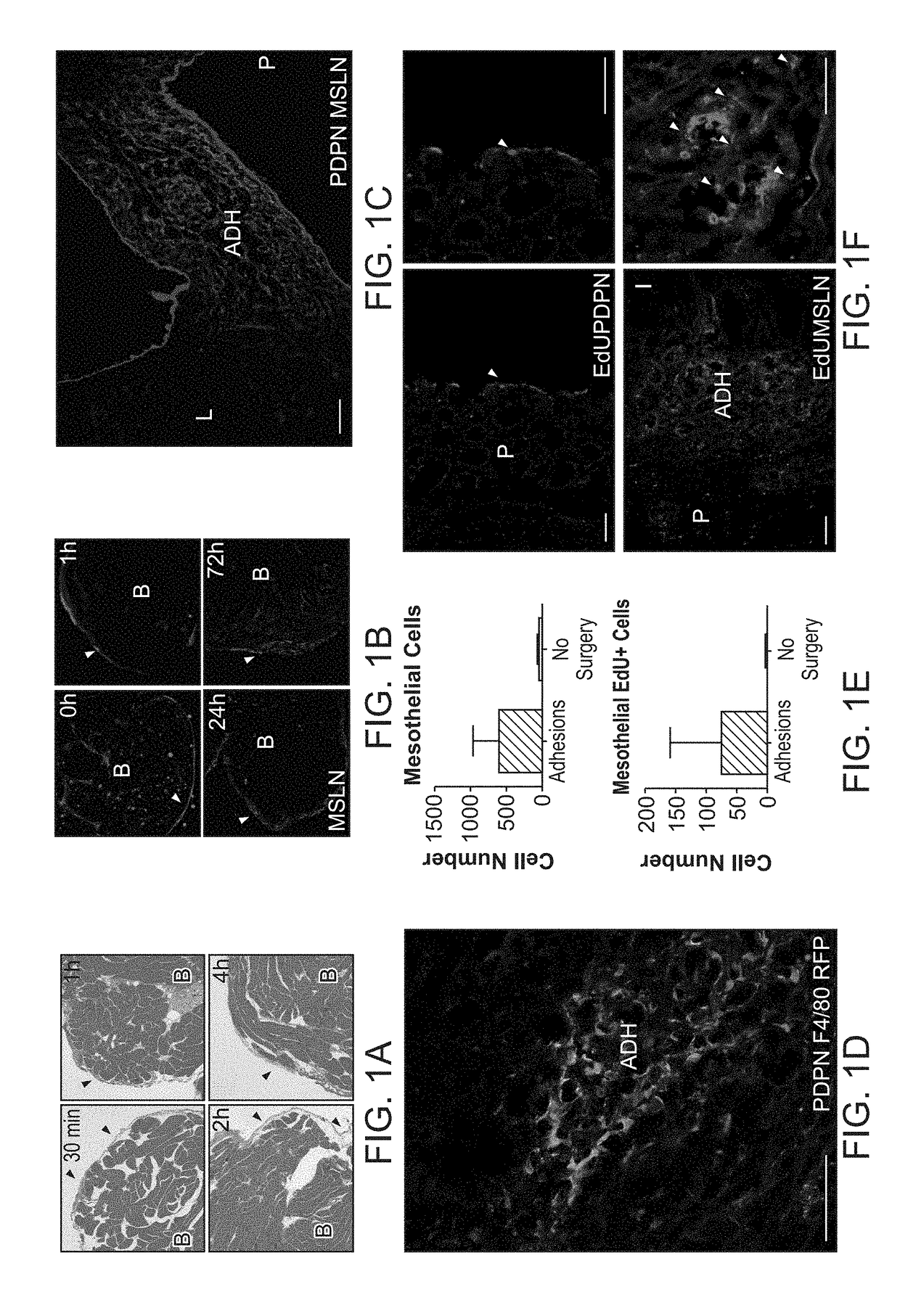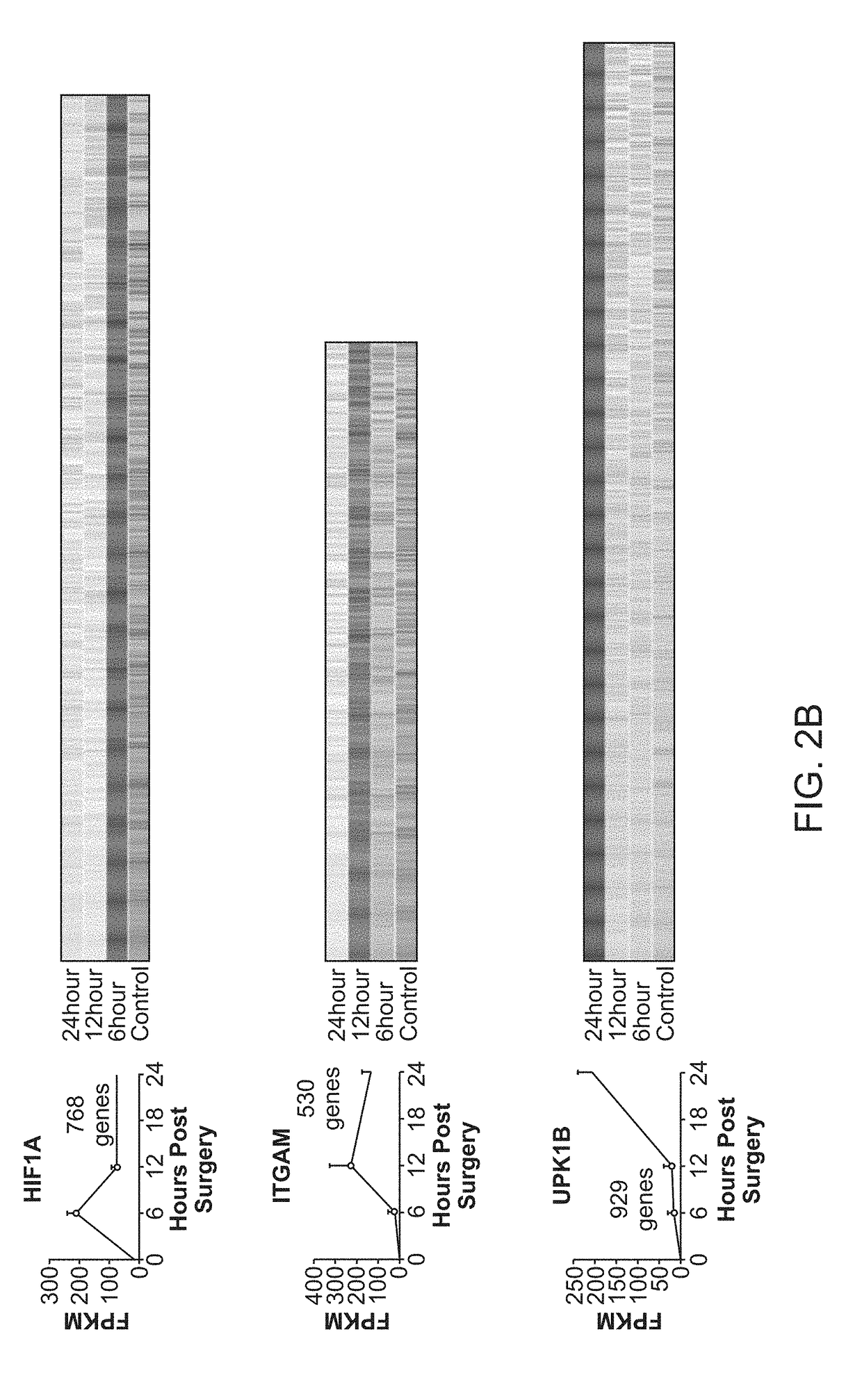Methods and compositions for the prevention and treatment of surgical adhesions
- Summary
- Abstract
- Description
- Claims
- Application Information
AI Technical Summary
Benefits of technology
Problems solved by technology
Method used
Image
Examples
example 1
Materials and Methods
Adhesion Induction
[0091]Adhesion induction surgeries were done on wild type B6 (C57BL / 6J (The Jackson Laboratory) mice aged 6-10 weeks. Mice were anesthetized by inhaled isoflurane until determined unconscious confirmed by toe-pinch test. The abdomen was disinfected with betadine and phosphate buffered saline (PBS). A left mid-clavicular incision was made in the skin running down the length of the mouse. A similar left-mid clavicular incision was made in the peritoneum running down the length of the peritoneum. The peritoneum was gently folded to the right and held down by a hemostat. A single, ischemic button was placed on the right half of the peritoneal wall by clamping a small (−5 mm diameter) piece of peritoneum and ligating the base with a 4-0 silk suture (Ethicon, 683G). Light abrasion on the button (24 times) and on the adjacent liver, cecum, and small and large bowels (7 times) was optionally performed (depending on the desired adhesion severity) with a...
example 2
A Neutrophil and Monocyte Axis Contributes Towards Adhesion Formation
[0139]RNA sequencing results from injured mesothelial cells over a 24 hour time course were taken from previous experiments (see Example 1) and showed differential expression of multiple genesets and processes, including inflammatory chemokines and cytokines (FIG. 9A). Specific neutrophil and macrophage recruitment signals, CXCL1, CCL2, and CXCL2, are immediately upregulated after 6 hours and stay increased over the first 24 hours. Peritoneal washes from similar time points confirmed that increased numbers of neutrophils and macrophages enter the peritoneum. Although previous studies have demonstrated that neutrophils and macrophages respond to and are involved in adhesion pathogenesis, little work has been done demonstrating which subsets of these hematopoietic cells play key roles. Adhesion induction, as previously described in Example 1, in parabiosis experiments between a mouse constitutively expressing the red...
example 3
[0140]Mice were pre-treated with either PLGA, thioglycollate, or PBS control 3 days prior to adhesion induction surgery as described in Example 1. Mice were evaluated 7 days post injury and evaluated on an adhesion severity scale from 0-5 for adhesions forming on the suture site (S) or the button (B). FIG. 10 shows that mice pretreated with PLGA or thioglycollate have significantly reduced severity of adhesions at both the suture site and button. We conclude that pretreatment with PLGA alone, thioglycollate alone, or a combination of PLGA and thioglycollate prior to surgery will reduce the formation and / or severity of adhesions in a subject.
PUM
| Property | Measurement | Unit |
|---|---|---|
| Digital information | aaaaa | aaaaa |
| Composition | aaaaa | aaaaa |
| Adhesion strength | aaaaa | aaaaa |
Abstract
Description
Claims
Application Information
 Login to View More
Login to View More - Generate Ideas
- Intellectual Property
- Life Sciences
- Materials
- Tech Scout
- Unparalleled Data Quality
- Higher Quality Content
- 60% Fewer Hallucinations
Browse by: Latest US Patents, China's latest patents, Technical Efficacy Thesaurus, Application Domain, Technology Topic, Popular Technical Reports.
© 2025 PatSnap. All rights reserved.Legal|Privacy policy|Modern Slavery Act Transparency Statement|Sitemap|About US| Contact US: help@patsnap.com



